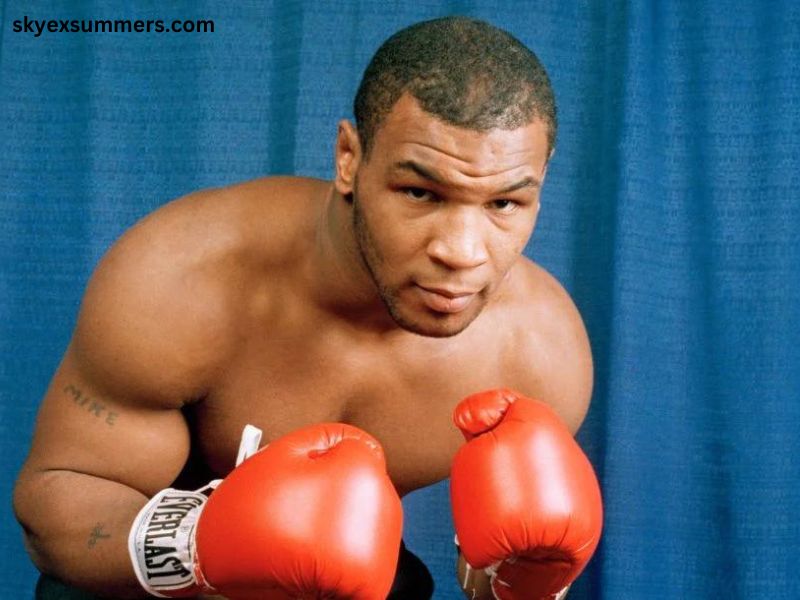Mike Tyson is a name that resonates with power, dominance, and sheer athleticism. Throughout his storied career in the world of boxing, he has left an indelible mark, not only due to his exceptional skills in the ring but also because of his physical attributes, including his weight. Weight, particularly in combat sports, plays a crucial role in determining a fighter’s strength, speed, endurance, and overall ability to compete. This article explores Mike Tyson’s weight over the years, delving into his prime fighting days, post-retirement physique, and how his weight has influenced his boxing prowess and public persona.
Mike Tyson’s Weight During His Prime
Mike Tyson made his professional boxing debut on March 6, 1985, at the age of 18, weighing around 214 pounds. Standing at 5’10” (178 cm), Tyson was considered relatively short for a heavyweight, but he made up for it with an exceptional combination of power, speed, and explosiveness. His weight was ideal for his frame, allowing him to move with agility while maintaining the ability to deliver devastating punches that often left his opponents unconscious within minutes of the first round.
At his peak, Tyson’s fighting weight typically hovered between 215 and 220 pounds. This was during his reign as the undisputed heavyweight champion from 1986 to 1990, a period in which he became the youngest boxer to win a heavyweight title at the age of 20. His physical build, especially his muscular upper body and compact frame, was a key factor in his ability to dominate larger opponents. The combination of a lower center of gravity, thick musculature, and relatively low body fat percentage contributed to his iconic style.
His weight remained relatively consistent throughout his prime years, with slight fluctuations depending on his conditioning and training. Tyson’s weight during his most iconic fights is often highlighted:
- Tyson vs. Trevor Berbick (1986): In the fight where Tyson won his first WBC heavyweight title, he weighed 221 pounds. At just 20 years old, he displayed phenomenal power and speed, knocking Berbick down twice in the second round, securing his first title.
- Tyson vs. Larry Holmes (1988): In his fight against the legendary former champion Larry Holmes, Tyson weighed 218 pounds. He knocked Holmes out in the fourth round, solidifying his dominance in the heavyweight division.
- Tyson vs. Michael Spinks (1988): Tyson weighed in at 218 pounds for what would be one of the most famous bouts of his career, where he knocked out Michael Spinks in just 91 seconds. This fight showcased Tyson at his most feared and dominant weight, where his blend of power and speed was virtually unmatched.
- Tyson vs. Buster Douglas (1990): Tyson weighed in at 220 pounds when he faced Buster Douglas in what became one of the greatest upsets in boxing history. Douglas knocked Tyson out in the 10th round, ending his reign as undisputed champion.
Weight Post-Prison and Career Comeback
Mike Tyson’s career experienced a significant pause in the early 1990s due to his conviction and imprisonment in 1992. During his time away from the sport, his weight fluctuated. After being released in 1995, Tyson returned to boxing, and while he was still a formidable fighter, his weight had slightly increased.
In his comeback bouts, Tyson weighed more than he did during his prime. For instance:
- Tyson vs. Peter McNeeley (1995): In his first fight after being released from prison, Tyson weighed 220 pounds. Despite the weight gain, he managed to knock out McNeeley in the first round, though many analysts believed he had lost some of the speed and sharpness that defined his earlier career.
- Tyson vs. Evander Holyfield (1996 & 1997): Tyson weighed around 222 pounds for both of his fights against Evander Holyfield. He lost the first fight via TKO in the 11th round and the second in the infamous “bite fight,” where Tyson bit Holyfield’s ear, resulting in his disqualification. Tyson’s increased weight didn’t seem to impact his power, but many believe it affected his endurance and agility.
As he entered his late 30s and early 40s, Tyson’s weight became a topic of discussion. He was no longer the lean, compact fighter he had been in his 20s, and his physical condition became a more pressing issue as he took on larger opponents. The increase in weight was attributed not just to natural aging but also to his tumultuous personal life and the wear and tear his body had endured after decades in the sport.
Mike Tyson’s Weight in Exhibition Fights
After retiring from professional boxing in 2005, Tyson’s weight fluctuated significantly, often reflecting his changing lifestyle. For a while, Tyson’s weight was reported to be much higher than during his active years, particularly during periods of personal and financial difficulties. By the time he reached his 40s and 50s, Tyson admitted to struggling with obesity and depression, which contributed to his weight gain.
However, in 2020, Tyson made a remarkable comeback to the ring, albeit in an exhibition fight. On November 28, 2020, at the age of 54, Tyson fought former four-division world champion Roy Jones Jr. in an eight-round exhibition match. Leading up to the fight, Tyson underwent a significant physical transformation, shedding weight and returning to a much leaner and muscular physique compared to his post-retirement years.
For the fight against Jones Jr., Tyson weighed in at 220.4 pounds, which was close to his prime fighting weight. Tyson’s transformation was impressive, given his age and the years of inactivity. In interviews, he credited his return to physical fitness to a strict vegan diet, intense training regimen, and renewed focus on his health.
Tyson’s weight for the exhibition fight was a testament to his discipline and natural ability to quickly return to fighting shape. Although the fight ended in a split draw, Tyson’s performance, especially his movement and stamina, was praised, showing that even in his 50s, he could still box at a high level.
The Influence of Weight on Tyson’s Style
Mike Tyson’s weight has been a crucial aspect of his fighting style throughout his career. Unlike many taller heavyweights who relied on their reach and height advantages, Tyson used his compact, muscular frame to deliver powerful hooks and uppercuts from close range. His weight allowed him to generate tremendous force in his punches, which often ended fights quickly. At his best, Tyson’s weight gave him the perfect balance between power and speed.
However, the increase in weight during the latter part of his career likely contributed to a decline in his performance. While his power remained, he lost some of the agility and head movement that had made him such a dangerous fighter in his prime. This weight gain, coupled with the effects of aging and time away from the ring, made it harder for Tyson to maintain the same level of dominance he once had.
Mike Tyson’s Current Weight and Lifestyle
As of 2024, Mike Tyson is in his late 50s and leads a more balanced and health-conscious lifestyle. He has embraced various business ventures, including his cannabis company and his popular podcast, “Hotboxin’ with Mike Tyson.” Tyson has been open about his struggles with weight in his post-boxing years, but he has remained committed to staying fit and healthy.
While Tyson no longer maintains the intense training regimen of his fighting days, he continues to work out regularly and follow a healthy diet. His current weight is estimated to be around 230 to 240 pounds, which is heavier than his prime but still well within a healthy range for someone of his stature.
Conclusion
Mike Tyson’s weight has played a pivotal role in his boxing career and life. From his early days as a lean and powerful heavyweight champion to his fluctuating post-retirement weight and his recent physical transformation, Tyson’s weight has always been a topic of interest. In the ring, his weight was a key factor in his ability to deliver knockout punches and dominate opponents. Today, Tyson continues to inspire others with his journey, showing that it’s possible to maintain health and fitness even after years of physical and emotional challenges.



